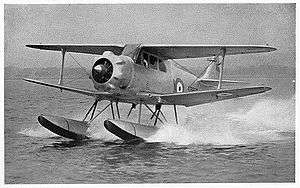Airspeed Queen Wasp
| AS.30 Queen Wasp | |
|---|---|
 | |
| Airspeed Queen Wasp, c. 1939 | |
| Role | Pilotless Target Aircraft |
| Manufacturer | Airspeed (1934) Ltd |
| Designer | Hessell Tiltman/N.S. Norway |
| First flight | 1937 |
| Introduction | 1937 |
| Primary user | Royal Air Force |
| Produced | 1937 |
| Number built | 5 (5 additional airframes not completed) |
|
| |
The Airspeed AS.30 Queen Wasp was a British pilotless target aircraft built by Airspeed Limited at Portsmouth during the Second World War. Although intended for both Royal Air Force and Royal Navy use, the aircraft was fated not to go into series production.
Design and development
The Queen Wasp was built to meet an Air Ministry Specification Q.32/35 for a pilotless target aircraft to replace the de Havilland Tiger Moth based de Havilland Queen Bee. Two prototypes were ordered in May 1936, one to have a wheeled landing gear for use by the Royal Air Force and the other as a floatplane for Royal Navy use for air-firing practice at sea. Powered by the Armstrong Siddeley Cheetah engine, a total of 65 aircraft were ordered, contingent on the success of the flight test programme.[1]
The aircraft was a single-engined biplane constructed of wood with sharply-tapered wings and fabric-covered control surfaces. An enclosed cabin with one seat was provided so the Queen Wasp could be flown manually with the radio control system turned off. The radio control system was complex with a number of backup safety devices to ensure radio and battery operation was uninterrupted. A trailing receiver aerial was winched out after takeoff and served as an automatic landing device which was activated when the trailing aerial weight hit the runway. The sensitivity of the system in turbulent weather meant that an alternative landing signal was used to initiate a landing procedure.[1]
The landplane first flew on 11 June 1937, and the floatplane on 19 October 1937. The floatplane was successfully catapulted from HMS Pegasus in November 1937.
Operational history
In flight tests, the aircraft was found to be underpowered and water handling difficulties necessitated a redesign of the floats by their builder Shorts. Although the production run of 10 aircraft was begun (P5441–P5450), only three more aircraft were completed and delivered to the Royal Air Force.[1]
Airspeed proposed a number of unsuccessful designs derived from the Queen Wasp including the AS.38 communications aircraft and the AS.50 trainer developed to meet Specification T.24/40.[1]
Operators
Specifications (Landplane)
General characteristics
- Length: 24 ft 4 in (7.42 m)
- Wingspan: 31 ft 0 in (9.45 m)
- Height: 10 ft 1 in (3.07 m)
- Max. takeoff weight: 3,500 lb (1588 kg)
- Powerplant: 1 × Armstrong Siddeley Cheetah IX radial piston engine, 350 hp (261 kw)
Performance
- Maximum speed: 172 mph (277 km/h)
- Service ceiling: 20,000 ft (6100 m)
See also
- Aircraft of comparable role, configuration and era
- Related lists
References
| Wikimedia Commons has media related to Airspeed Queen Wasp. |
- Notes
- Bibliography
- "Airspeed AS.30 Queen Wasp." Control Column, Official Organ of the British Aircraft Preservation Council, Volume 12, No. 2, February/March 1978.
- The Illustrated Encyclopedia of Aircraft (Part Work 1982-1985). London: Orbis Publishing, 1985.
